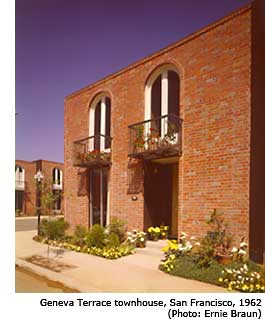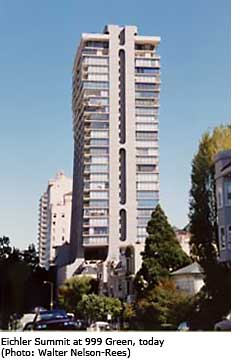Last Days of Eichler Homes - Page 2
 By 1966, the company assets had become depleted to an alarming degree and Eichler had begun to suffer physically from the resulting stress. Even the suburban developments had run into difficulties. That year, Eichler fell ill, suffering from heart problems, and had to be hospitalized. He called upon his son Ned, who at that time had been away from the company while consulting with the University of California at Berkeley, to step back in and help manage in his father's absence. Ned found his father "completely flat," lacking any of his usual energy or enthusiasm. Depressed over the company's finances, Joe asked Ned to review the assets. Ned's review revealed the company to be near collapse, and he recommended filing for Chapter 11 bankruptcy. The senior Eichler refused, hoping that he could restore the company's success, and not wishing to harm his reputation with negative publicity just as some of his most personally satisfying work was close to realization. Geneva Towers was then nearly 90 percent finished. The project had been important for Eichler's sense of social responsibility, representing the largest project in the country under a federally sponsored program that allowed units to be purchased at below-market rates. Eichler had received some gratifying publicity early on when Vice-President Hubert Humphrey had attended the groundbreaking ceremonies. However, the construction had gone over budget, and Ned took over the completion of the project, managing a deficit of nearly a million dollars through an out-of-court bankruptcy procedure. The company remained teetering on the edge of insolvency, still building in the suburban developments, but losing money nonetheless. Joe Eichler, perhaps denying the true state of affairs, remained devoted to saving his business, and at the least, anxious to stave off the ignominy of bankruptcy.
By 1966, the company assets had become depleted to an alarming degree and Eichler had begun to suffer physically from the resulting stress. Even the suburban developments had run into difficulties. That year, Eichler fell ill, suffering from heart problems, and had to be hospitalized. He called upon his son Ned, who at that time had been away from the company while consulting with the University of California at Berkeley, to step back in and help manage in his father's absence. Ned found his father "completely flat," lacking any of his usual energy or enthusiasm. Depressed over the company's finances, Joe asked Ned to review the assets. Ned's review revealed the company to be near collapse, and he recommended filing for Chapter 11 bankruptcy. The senior Eichler refused, hoping that he could restore the company's success, and not wishing to harm his reputation with negative publicity just as some of his most personally satisfying work was close to realization. Geneva Towers was then nearly 90 percent finished. The project had been important for Eichler's sense of social responsibility, representing the largest project in the country under a federally sponsored program that allowed units to be purchased at below-market rates. Eichler had received some gratifying publicity early on when Vice-President Hubert Humphrey had attended the groundbreaking ceremonies. However, the construction had gone over budget, and Ned took over the completion of the project, managing a deficit of nearly a million dollars through an out-of-court bankruptcy procedure. The company remained teetering on the edge of insolvency, still building in the suburban developments, but losing money nonetheless. Joe Eichler, perhaps denying the true state of affairs, remained devoted to saving his business, and at the least, anxious to stave off the ignominy of bankruptcy.
Eichler may have become somewhat desperate for solutions at this time, and vulnerable to farfetched remedies. It was during this trying period that two potential investors approached him: Charles Parr, a successful owner of a Los Angeles advertising firm and part-time real estate investor; and Robert Bryson, an entrepreneurial investor. According to his son, R.J., the senior Parr had had some impressive successes reconstituting struggling building companies in Southern California, and had shown a genuine aptitude for securing financing for some large-scale construction projects, including the B'Nai Brith Hospital in Los Angeles. He also had great admiration for Eichler, and was eager to emulate his success with homebuilding. In May 1966, with Bryson's help, Parr offered to buy a controlling interest in Eichler Homes. Ned Eichler recalled that while neither Parr nor Bryson appeared to have the capital necessary to absolve the company's debts, they managed to secure some financing and purchased Joe Eichler's and Ned's stock with promissory notes. Ned's brother, Richard, perhaps suspecting that the two potential owners were in over their heads, insisted upon cash for his shares. Parr and Bryson assumed the roles of president and vice president, respectively, while Eichler stayed on as chairman. Difficulties began for the new owners almost immediately, and the company continued to shrink as losses mounted.
Parr had admired Joe Eichler's achievements and, according to his son R.J., had hoped to duplicate and perhaps exceed Eichler's earlier success. R.J. recalled his father's hopes for a revived Eichler Homes when he emphasized: "This was an opportunity for Charles to turn something around." He also remembered that there was interest in expanding the Southern California operation, an idea Eichler and Parr both initially seemed to agree on. Parr even imagined expanding the company as far as Chicago and Florida, and hoped Eichler Homes could partner with other established builders, including Kaufman and Broad, in an effort to expand their prospects. Parr's belief that this was possible may have been bolstered by a trend, which began in the late 1960s, wherein large corporations invested heavily in building companies. Ned Eichler recalled one Bay Area builder, Danny Schwartz, whose company had been known by local members of the building industry to be in poor financial shape, who sold his business to a major corporation for some $12 million. By the time Parr and Bryson acquired Eichler Homes, it is likely that they would have had trouble convincing prospective buyers, especially those that were in the industry, to invest. Eichler Homes had some 7,000 creditors, and the San Francisco projects, being so much more difficult than those that had created the company's earlier success, had financially overwhelmed the company. This, Ned Eichler affirmed, would have been all too apparent to anyone.





